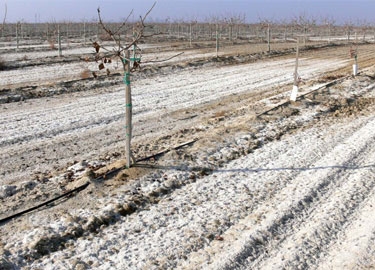Posts Tagged: Blake Sanden
UC ANR expert provides ag angle on student talk show
The myriad concerns related to California's fourth year of drought were raised during a California State University, Northridge, student talk show that featured a UC Agriculture and Natural Resources (UC ANR) farming expert.
UC ANR Cooperative Extension advisor Blake Sanden was joined on the show, titled On Point, by CSUN sustainability professor Helen Cox and geography professor Amalie Orme. Sanden spoke to the issues related to the agriculture industry. He noted that well-known San Joaquin Valley farmer and rancher John Harris, who manages 7,000 acres of land, is fallowing more than half of it this year and using all the water he has available to irrigate tree crops planted on 2,800 acres.
Asked whether he felt agriculture played a role contributing to the drought, Sanden explained that farmers consider a complete water budget when planning crops and are cognizant of the drought situation in low-precipitation years. He acknowledged that there are human-caused issues related to the drought, noting that the state has placed a priority on environmental preservation, which also requires a great deal of water.
Sanden commented on the now commonly shared fact that it takes a gallon of water to produce a single almond. Indeed, he said, it takes 50 gallons to grow one orange and as much as 100 gallons to produce a glass of milk from cows fed irrigated alfalfa.
"I hear these things going on and sometimes I just have to shake my head," he said. "Somebody is looking for a story with the gallon-per-nut catch phrase and they're not looking at the larger picture."
Recycled irrigation water raises food safety questions
"Everyone smells the petrochemicals in the irrigation water," said Blake Sanden, UC Agriculture and Natural Resources Cooperative Extension advisor in Kern County. "When I talk to growers, and they smell the oil field crap in that water, they assume the soil is taking care of this."
The farmers trust that organisms in the soil remove toxins or impurities in the water. However, the trust may be misplaced.
Microoganisms in soils can consume and process some impurities, Sanden said, but it's not clear whether oil field waste is making its way into the roots or leaves of irrigated plants, and then into the food chain.
It's unlikely that petrochemicals will show up in an almond, for example, he said, "But can they make it into the flesh of an orange or grape? It's possible. A lot of this stuff has not been studied in a field setting or for commercial food uptake."
The reporter also spoke to Carl Winter, a UC ANR Cooperative Extension specialist based at UC Davis. He said some plants can absorb toxins without transferring them to the leaves or the flesh of their fruit.
Still, he said, "it's difficult to say anything for sure because we don't know what chemicals are in the water."
A visiting scholar at UC Berkeley who is a researcher analyzing hydraulic fracturing for the California legislature said the issue is "one of the things that keeps me up at night."
"You can't find what you don't look for," he said.
Farmers dealing with unwelcome 'snow'
Due to the lingering drought, farms in the San Joaquin Valley are being found with an unwelcome white dusting of "snow" on the soil surface. It isn't the snow so desperately needed in California's high country; rather it is salt and other toxins that have precipitated out of the soil because of sparse winter rains, reported Dennis Pollock in Western Farm Press.
At the recent California Plant and Soil Conference in Fresno, multiple speakers showed pictures of what they labeled "California snow," the article said.
Plant toxins like selenium, boron and salt leach out with water, but water is in short supply this year. "That's why a lot of land is fallow," said Gary Banuelos, USDA-ARS researcher in Parlier.
At the conference, Rick Snyder, UC Cooperative Extension specialist in the Department of Land, Air and Water Resources at UC Davis, said applying less water will reduce deep percolation and could result in higher salinity in the rooting zone. Eventually deficit irrigation will become problematic, especially if practiced over a longterm drought.
Snyder said it might be better to apply available water to a smaller area to maintain production. In the case of permanent crops, he suggested the same frequency of irrigation, but using less water with each application.
David Doll, UCCE farm advisor in Merced County, said almonds are sensitive to high levels of sodium, chloride and boron; and that some rootstocks are more tolerant of saline conditions than others.
Dan Putnam, UCCE specialist in the Department of Plant Sciences at UC Davis, said alfalfa may be capable of tolerating higher salt levels than previously thought.
Some degraded water that could not be used on food crops can be used on alfalfa, he said, adding that alfalfa is in higher demand than many other salt-tolerant plants. While salinity may trigger a decline in percentage of germinated seeds, Putnam said, “that doesn't scare us; we can live with a 40 percent level.”
Blake Sanden, UCCE advisor in Kern County, said there are research gaps with regard to soil toxin tolerance in pistachios.
However, he said, a buildup of boron in the soil is "a potential boron time bomb."
Sanden's research showed a doubling of total boron in the soil after nine years. Without 6 to 10 inches of rainfall or fresh water winter irrigation for leaching every one to two years, he said, high levels of boron could render pistachio production unsustainable.




